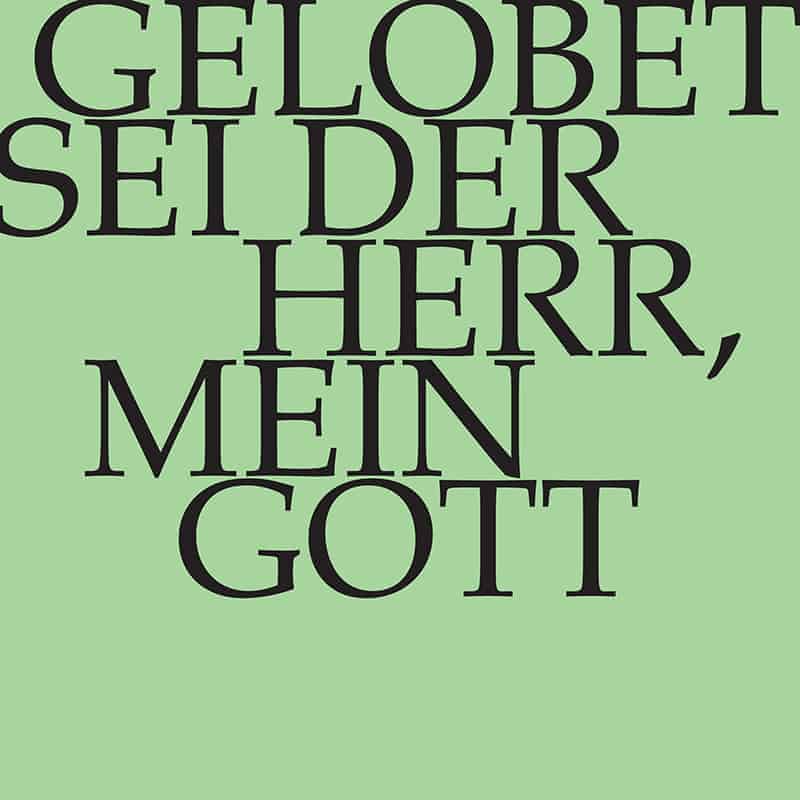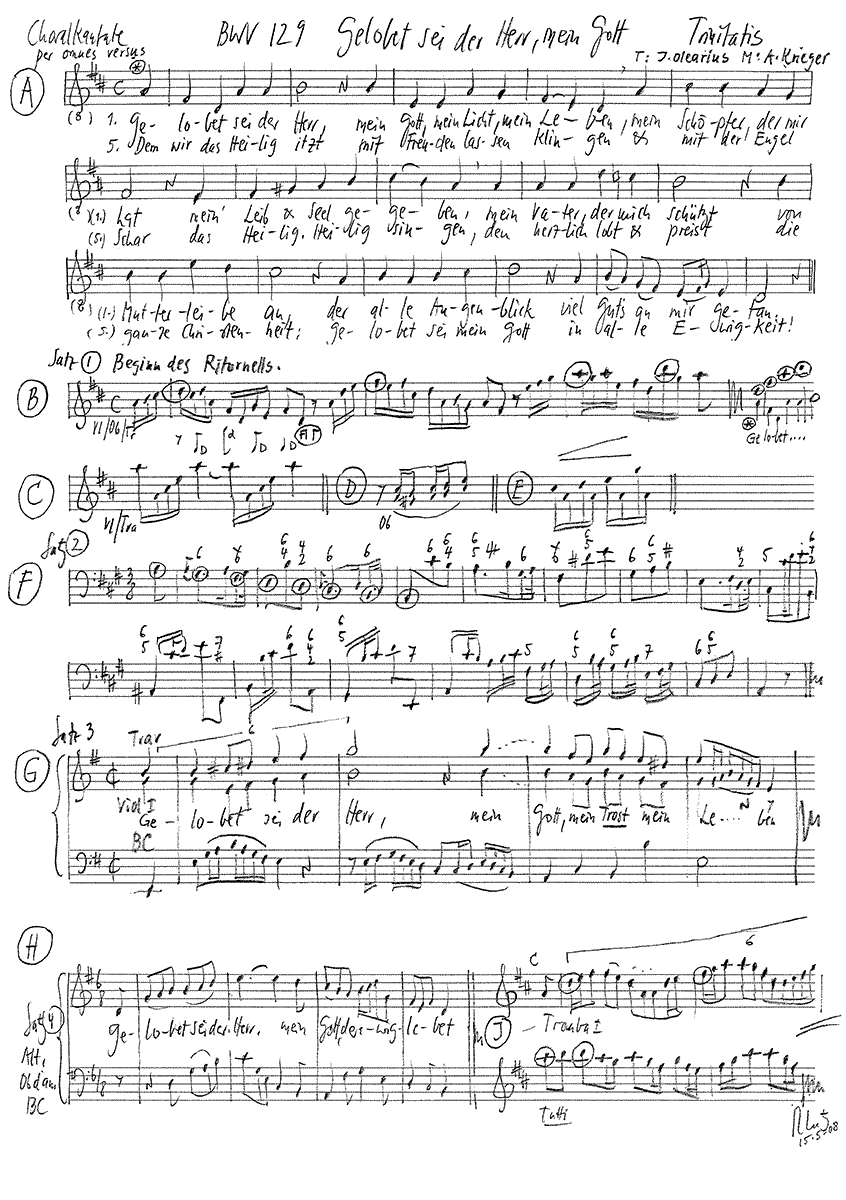Gelobet sei der Herr, mein Gott
BWV 129 // For Trinity Sunday
(Give honour to the Lord, my God) for soprano, alto and bass, vocal ensemble, trumpets I-III, timpani, flute, oboe I+II, bassoon, strings and continuo.
In his cantata “Gelobt sei der Herr, mein Gott” (Give honour to the Lord, my God) BWV 129 Bach presents a celebratory work of great magnificence and yet extraordinary efficiency. Written in the form of a chorale cantata “per omnes versus”, it is based solely on the verses of a church hymn and does not contain any transitional recitatives or aria texts. The composer was thus not able to depend on variety in form or speech rhythms for effect; rather, he had to draw solely upon his own musical inventiveness and skill for variety. BWV 129 belongs to the cantatas that Bach composed retrospectively in order to complete the choralecantata cycle he prematurely discontinued at Easter of 1725. In light of this, it is no great surprise that the work displays such a masterly command of the chorale technique.
Link to the illustration of God with three faces (trifrons) as an image of the Trinity. St. Peter’s Church, Basel, Switzerland. Source: Wikipedia

Would you like to enjoy our videos ad-free? Subscribe to YouTube Premium now...
Workshop
Reflective lecture
Bonus material
Choir
Soprano
Susanne Frei, Guro Hjemli,
Leonie Gloor, Noëmi Tran Rediger
Alto
Antonia Frey, Jan Börner, Olivia Heiniger, Lea Scherer
Tenor
Walter Siegel, Marcel Fässler, Clemens Flämig
Bass
Fabrice Hayoz, William Wood, Manuel Walser
Orchestra
Conductor & cembalo
Rudolf Lutz
Violin
Renate Steinmann, Martin Korrodi, Sylvia Gmür, Sabine Hochstrasser, Fanny Tschanz, Livia Wiersich
Viola
Susanna Hefti, Joanna Bilger, Roberta Centurione
Violoncello
Ilze Grudule
Violone
Iris Finkbeiner
Oboe
Stefanie Haegele
Oboe d’amore
Esther Fluor
Bassoon
Susann Landert
Tromba da tirarsi
Patrick Henrichs, Peter Hasel, Klaus Pfeiffer
Transverse flute
Claire Genewein
Timpani
Martin Homann
Organ
Norbert Zeilberger
Musical director & conductor
Rudolf Lutz
Workshop
Participants
Karl Graf, Rudolf Lutz
Reflective lecture
Speaker
Felizitas Gräfin Von Schönborn
Recording & editing
Recording date
05/16/2008
Recording location
Trogen
Sound engineer
Stefan Ritzenthaler
Director
Meinrad Keel
Production manager
Johannes Widmer
Production
GALLUS MEDIA AG, Switzerland
Producer
J.S. Bach Foundation of St. Gallen, Switzerland
Librettist
Text
Johann Olearius, 1665
Year of composition
1726
In-depth analysis
The opening chorus, grandly scored with three trumpets, timpani, woodwinds, strings and choir, puts forth a cheerful character. The chorale, delivered by the soprano in long tones, is worked line for line into a lively orchestral ritornello punctuated by sonorous trumpet interjections, while three lower voices provide an accompaniment of partially independent thematic material. As fitting for a festive cantata, the final chorale is also not scored as a simple four-voice movement. Evidently, Bach could not resist devising a magnificent accompaniment that provides a glorious setting for the chorale text. The three inner verses of this movement display a highly sensitive character; the tonal colour and shades of meaning that Bach lends the key word “praise” is nothing short of phenomenal. In these verses, three different temperaments and generations of man seem to contribute to the glorification of the Trinity: from the dignified old man of the bass voice, to the innocent child of the soprano, to the elegant middle years of the alto. It also seems entirely permissible to interpret the three verses as representing the Trinity of God the Father, God the Son and God the Holy Ghost.
The bass aria, (verse 2), accompanied only by the continuo, provides a stark contrast to the opening chorus. However, the 16 bar ritornello is so melodically energetic that it veritably cries out for an accompanying text. The third aria is a cantabile trio of oboe d’amore, continuo and alto, whose gentle 6⁄8 metre soon has head, hands and body swaying in time. In contrast, the soprano aria – the centrepiece of the cantata – is one of Bach’s most magnificent creations. With is sombre accompaniment of transverse flute, violin and continuo, it constitutes a captivating quartet movement. Composed in an elegiac e minor, yet in perpetual motion, a window of emotional turmoil and ardent rapture is opened amidst the festive splendour – a gesture that touches the souls of listeners even today. One can imagine with what childlike fervency and do-or-die courage that Bach’s young boy sopranos would have tackled the murderously high sections of this movement. The timeless fascination the old chorale melodies held for Bach and still hold for us today is seldom felt so directly as in this poignant aria miniature.
Libretto
1. Chor
Gelobet sei der Herr,
mein Gott, mein Licht, mein Leben,
mein Schöpfer, der mir hat
mein’ Leib und Seel gegeben,
mein Vater, der mich schützt
von Mutterleibe an,
der alle Augenblick
viel Guts an mir getan.
2. Arie (Bass)
Gelobet sei der Herr,
mein Gott, mein Heil, mein Leben,
des Vaters liebster Sohn,
der sich für mich gegeben,
der mich erlöset hat
mit seinem teuren Blut,
der mir im Glauben schenkt
sich selbst, das höchste Gut.
3. Arie (Sopran)
Gelobet sei der Herr,
mein Gott, mein Trost, mein Leben,
des Vaters werter Geist,
den mir der Sohn gegeben,
der mir mein Herz erquickt,
der mir gibt neue Kraft,
der mir in aller Not
Rat, Trost und Hülfe schafft.
4. Arie (Alt)
Gelobet sei der Herr,
mein Gott, der ewig lebet,
den alles lobet, was
in allen Lüften schwebet;
gelobet sei der Herr,
des Name heilig heisst,
Gott Vater, Gott der Sohn
und Gott der Heilge Geist.
5. Choral
Dem wir das Heilig itzt
mit Freuden lassen klingen
und mit der Engel Schar
das Heilig, Heilig singen,
den herzlich lobt und preist
die ganze Christenheit:
Gelobet sei mein Gott
in alle Ewigkeit!



